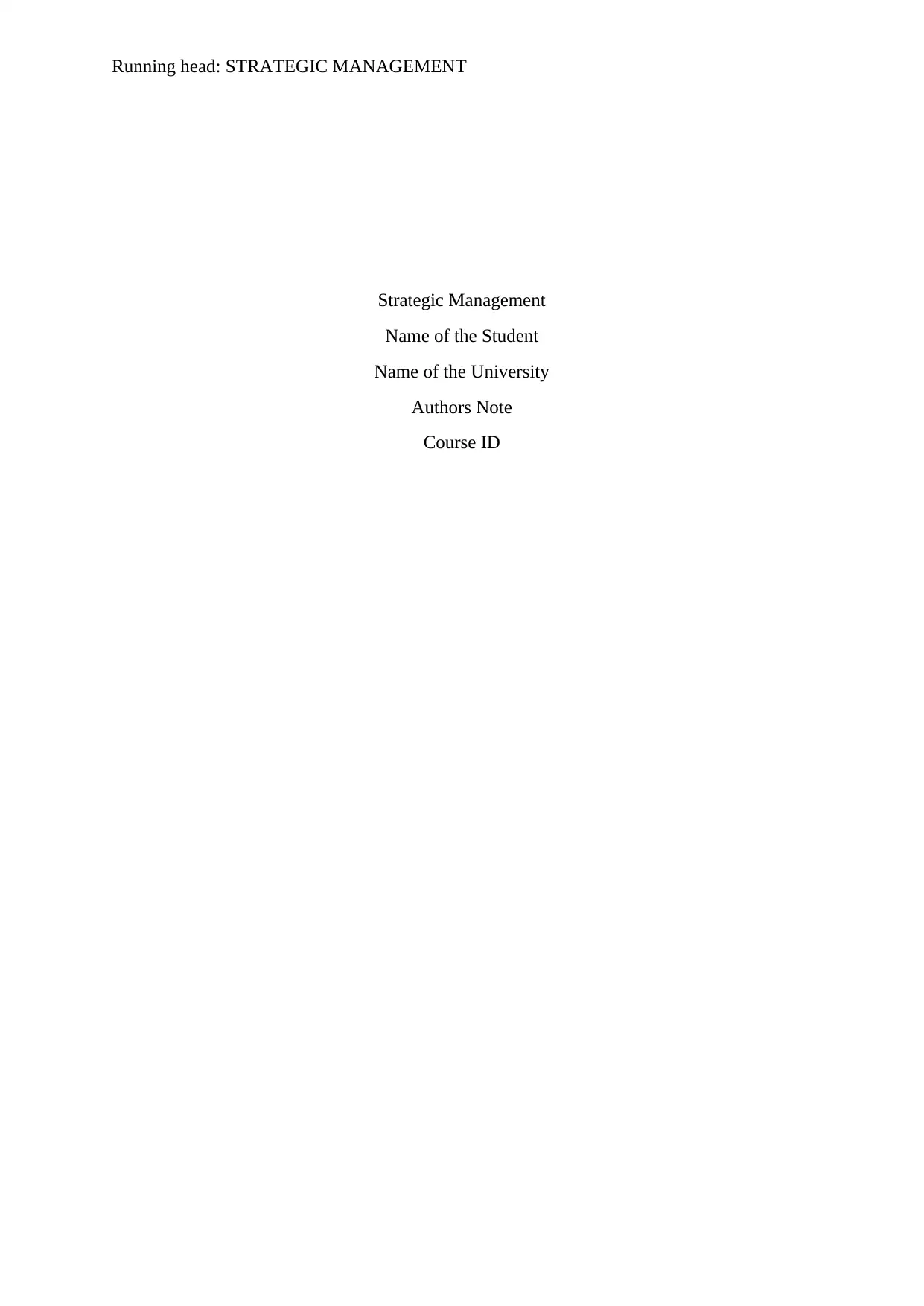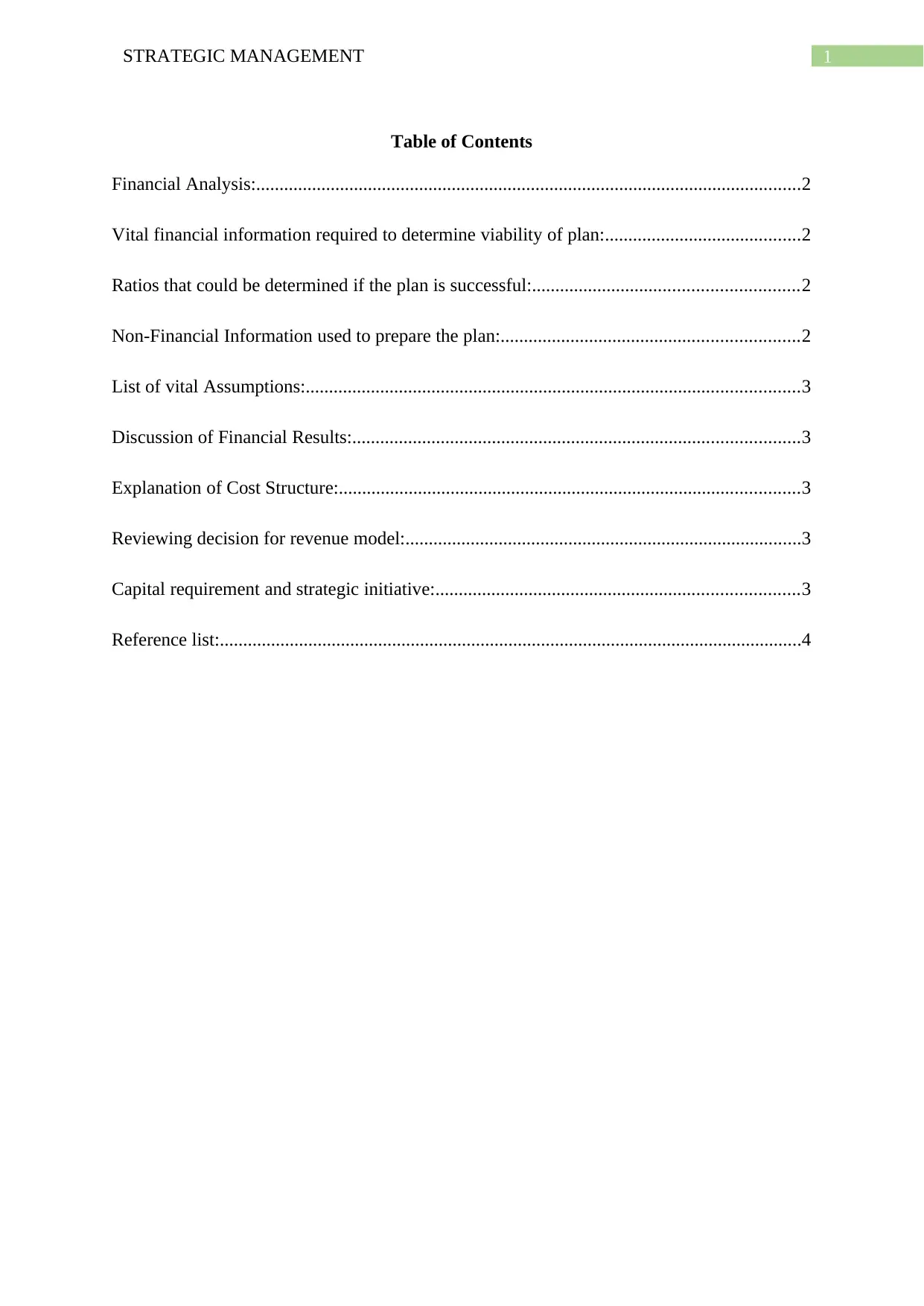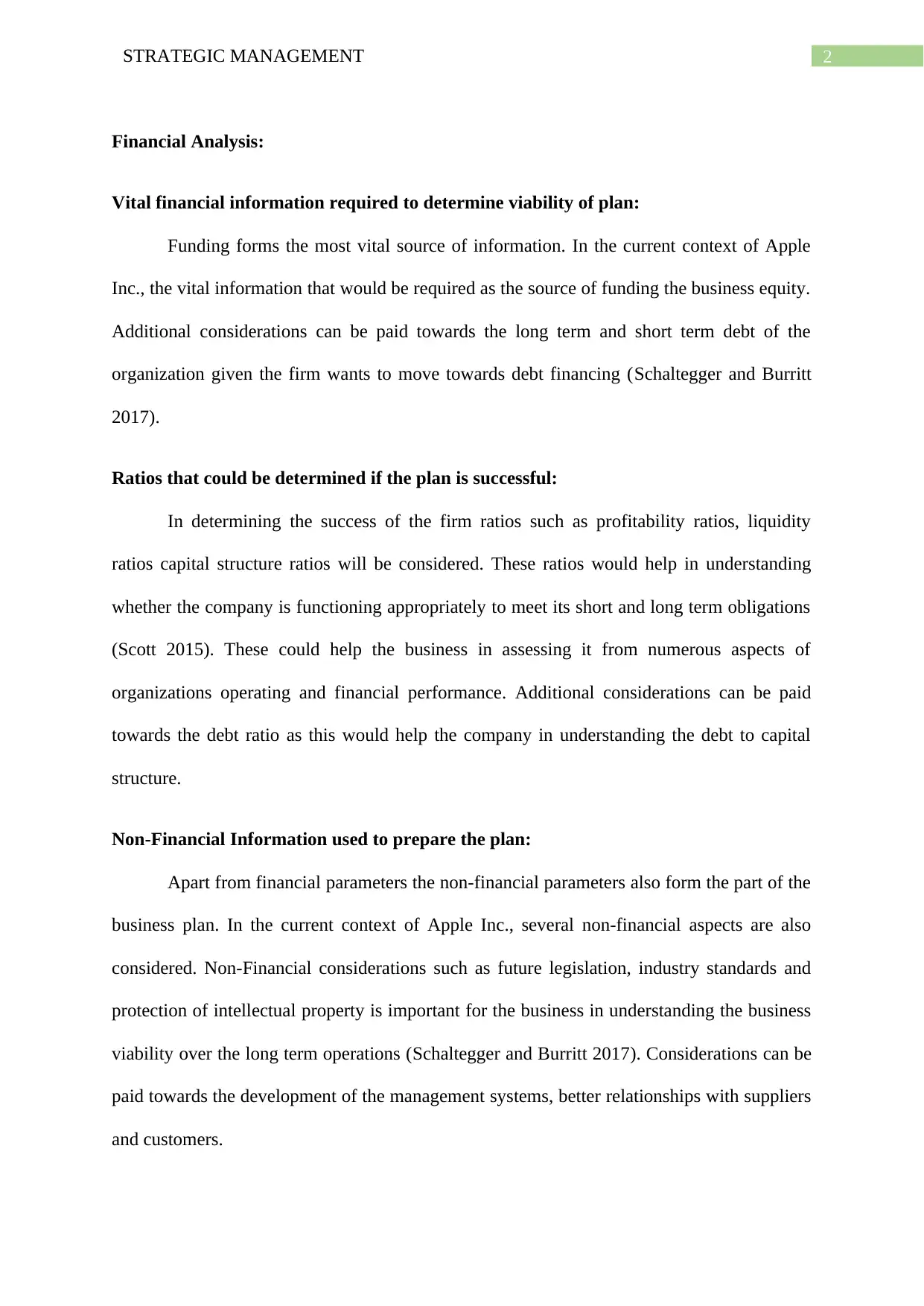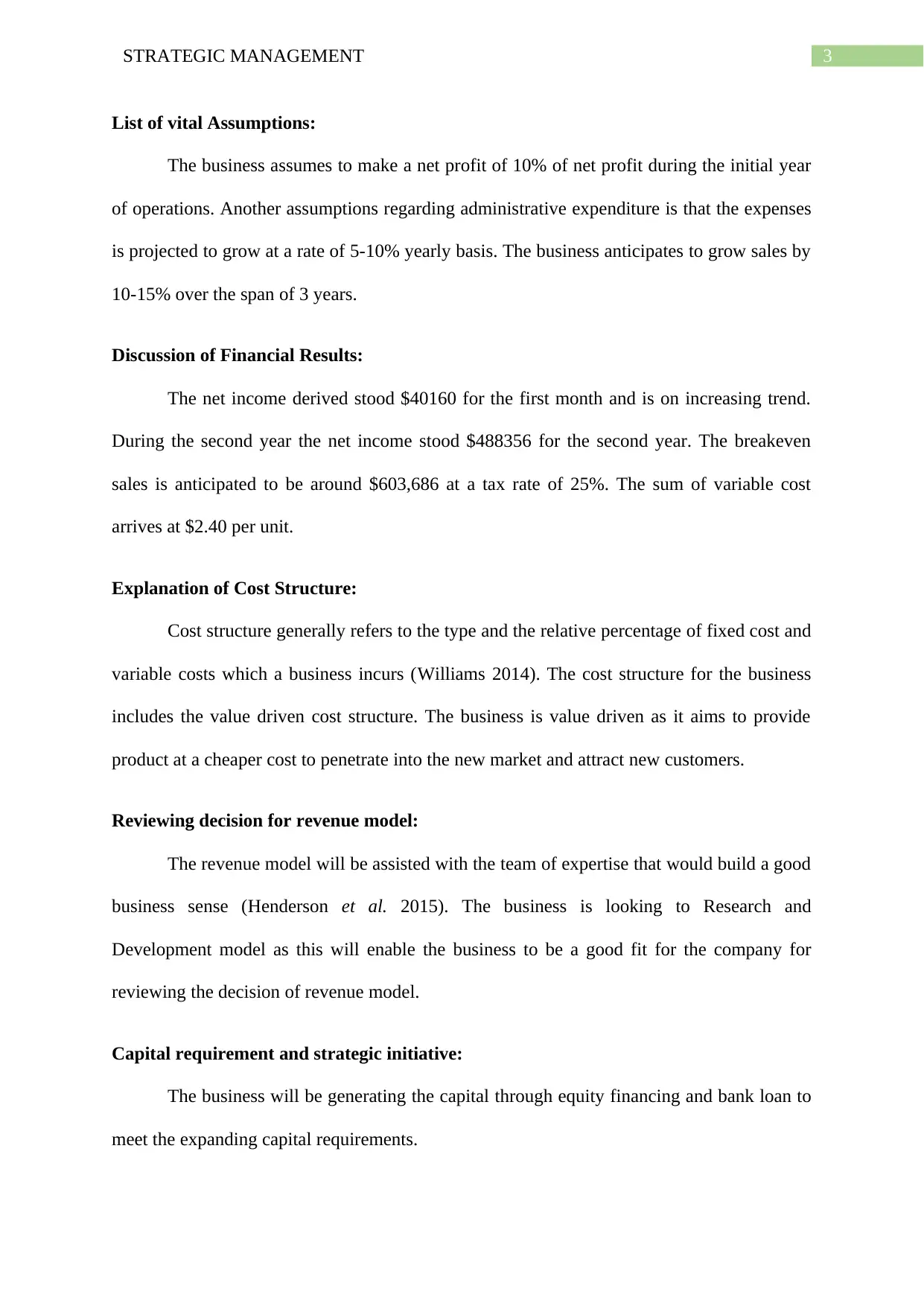Strategic Management Report: Financial and Non-Financial Analysis
VerifiedAdded on 2021/04/24
|5
|752
|58
Report
AI Summary
This report provides a strategic management analysis of Apple Inc., focusing on key financial and non-financial aspects. It examines vital financial information, including funding sources, and relevant ratios for assessing the company's success. The report delves into non-financial considerations like industry standards and intellectual property protection. It outlines business assumptions, discusses financial results, and explains the cost structure, emphasizing the value-driven approach. Furthermore, the report reviews the revenue model, highlighting the role of research and development, and addresses capital requirements and strategic initiatives, including equity financing and bank loans. The analysis incorporates references to academic sources to support its findings.

Running head: STRATEGIC MANAGEMENT
Strategic Management
Name of the Student
Name of the University
Authors Note
Course ID
Strategic Management
Name of the Student
Name of the University
Authors Note
Course ID
Paraphrase This Document
Need a fresh take? Get an instant paraphrase of this document with our AI Paraphraser

1STRATEGIC MANAGEMENT
Table of Contents
Financial Analysis:.....................................................................................................................2
Vital financial information required to determine viability of plan:..........................................2
Ratios that could be determined if the plan is successful:.........................................................2
Non-Financial Information used to prepare the plan:................................................................2
List of vital Assumptions:..........................................................................................................3
Discussion of Financial Results:................................................................................................3
Explanation of Cost Structure:...................................................................................................3
Reviewing decision for revenue model:.....................................................................................3
Capital requirement and strategic initiative:..............................................................................3
Reference list:.............................................................................................................................4
Table of Contents
Financial Analysis:.....................................................................................................................2
Vital financial information required to determine viability of plan:..........................................2
Ratios that could be determined if the plan is successful:.........................................................2
Non-Financial Information used to prepare the plan:................................................................2
List of vital Assumptions:..........................................................................................................3
Discussion of Financial Results:................................................................................................3
Explanation of Cost Structure:...................................................................................................3
Reviewing decision for revenue model:.....................................................................................3
Capital requirement and strategic initiative:..............................................................................3
Reference list:.............................................................................................................................4

2STRATEGIC MANAGEMENT
Financial Analysis:
Vital financial information required to determine viability of plan:
Funding forms the most vital source of information. In the current context of Apple
Inc., the vital information that would be required as the source of funding the business equity.
Additional considerations can be paid towards the long term and short term debt of the
organization given the firm wants to move towards debt financing (Schaltegger and Burritt
2017).
Ratios that could be determined if the plan is successful:
In determining the success of the firm ratios such as profitability ratios, liquidity
ratios capital structure ratios will be considered. These ratios would help in understanding
whether the company is functioning appropriately to meet its short and long term obligations
(Scott 2015). These could help the business in assessing it from numerous aspects of
organizations operating and financial performance. Additional considerations can be paid
towards the debt ratio as this would help the company in understanding the debt to capital
structure.
Non-Financial Information used to prepare the plan:
Apart from financial parameters the non-financial parameters also form the part of the
business plan. In the current context of Apple Inc., several non-financial aspects are also
considered. Non-Financial considerations such as future legislation, industry standards and
protection of intellectual property is important for the business in understanding the business
viability over the long term operations (Schaltegger and Burritt 2017). Considerations can be
paid towards the development of the management systems, better relationships with suppliers
and customers.
Financial Analysis:
Vital financial information required to determine viability of plan:
Funding forms the most vital source of information. In the current context of Apple
Inc., the vital information that would be required as the source of funding the business equity.
Additional considerations can be paid towards the long term and short term debt of the
organization given the firm wants to move towards debt financing (Schaltegger and Burritt
2017).
Ratios that could be determined if the plan is successful:
In determining the success of the firm ratios such as profitability ratios, liquidity
ratios capital structure ratios will be considered. These ratios would help in understanding
whether the company is functioning appropriately to meet its short and long term obligations
(Scott 2015). These could help the business in assessing it from numerous aspects of
organizations operating and financial performance. Additional considerations can be paid
towards the debt ratio as this would help the company in understanding the debt to capital
structure.
Non-Financial Information used to prepare the plan:
Apart from financial parameters the non-financial parameters also form the part of the
business plan. In the current context of Apple Inc., several non-financial aspects are also
considered. Non-Financial considerations such as future legislation, industry standards and
protection of intellectual property is important for the business in understanding the business
viability over the long term operations (Schaltegger and Burritt 2017). Considerations can be
paid towards the development of the management systems, better relationships with suppliers
and customers.
⊘ This is a preview!⊘
Do you want full access?
Subscribe today to unlock all pages.

Trusted by 1+ million students worldwide

3STRATEGIC MANAGEMENT
List of vital Assumptions:
The business assumes to make a net profit of 10% of net profit during the initial year
of operations. Another assumptions regarding administrative expenditure is that the expenses
is projected to grow at a rate of 5-10% yearly basis. The business anticipates to grow sales by
10-15% over the span of 3 years.
Discussion of Financial Results:
The net income derived stood $40160 for the first month and is on increasing trend.
During the second year the net income stood $488356 for the second year. The breakeven
sales is anticipated to be around $603,686 at a tax rate of 25%. The sum of variable cost
arrives at $2.40 per unit.
Explanation of Cost Structure:
Cost structure generally refers to the type and the relative percentage of fixed cost and
variable costs which a business incurs (Williams 2014). The cost structure for the business
includes the value driven cost structure. The business is value driven as it aims to provide
product at a cheaper cost to penetrate into the new market and attract new customers.
Reviewing decision for revenue model:
The revenue model will be assisted with the team of expertise that would build a good
business sense (Henderson et al. 2015). The business is looking to Research and
Development model as this will enable the business to be a good fit for the company for
reviewing the decision of revenue model.
Capital requirement and strategic initiative:
The business will be generating the capital through equity financing and bank loan to
meet the expanding capital requirements.
List of vital Assumptions:
The business assumes to make a net profit of 10% of net profit during the initial year
of operations. Another assumptions regarding administrative expenditure is that the expenses
is projected to grow at a rate of 5-10% yearly basis. The business anticipates to grow sales by
10-15% over the span of 3 years.
Discussion of Financial Results:
The net income derived stood $40160 for the first month and is on increasing trend.
During the second year the net income stood $488356 for the second year. The breakeven
sales is anticipated to be around $603,686 at a tax rate of 25%. The sum of variable cost
arrives at $2.40 per unit.
Explanation of Cost Structure:
Cost structure generally refers to the type and the relative percentage of fixed cost and
variable costs which a business incurs (Williams 2014). The cost structure for the business
includes the value driven cost structure. The business is value driven as it aims to provide
product at a cheaper cost to penetrate into the new market and attract new customers.
Reviewing decision for revenue model:
The revenue model will be assisted with the team of expertise that would build a good
business sense (Henderson et al. 2015). The business is looking to Research and
Development model as this will enable the business to be a good fit for the company for
reviewing the decision of revenue model.
Capital requirement and strategic initiative:
The business will be generating the capital through equity financing and bank loan to
meet the expanding capital requirements.
Paraphrase This Document
Need a fresh take? Get an instant paraphrase of this document with our AI Paraphraser

4STRATEGIC MANAGEMENT
Reference list:
Henderson, S., Peirson, G., Herbohn, K. and Howieson, B., 2015. Issues in financial
accounting. Pearson Higher Education AU.
Schaltegger, S. and Burritt, R., 2017. Contemporary environmental accounting: issues,
concepts and practice. Routledge.
Scott, W.R., 2015. Financial accounting theory (Vol. 2, No. 0, p. 0). Prentice Hall.
Williams, J., 2014. Financial accounting. McGraw-Hill Higher Education.
Reference list:
Henderson, S., Peirson, G., Herbohn, K. and Howieson, B., 2015. Issues in financial
accounting. Pearson Higher Education AU.
Schaltegger, S. and Burritt, R., 2017. Contemporary environmental accounting: issues,
concepts and practice. Routledge.
Scott, W.R., 2015. Financial accounting theory (Vol. 2, No. 0, p. 0). Prentice Hall.
Williams, J., 2014. Financial accounting. McGraw-Hill Higher Education.
1 out of 5
Related Documents
Your All-in-One AI-Powered Toolkit for Academic Success.
+13062052269
info@desklib.com
Available 24*7 on WhatsApp / Email
![[object Object]](/_next/static/media/star-bottom.7253800d.svg)
Unlock your academic potential
Copyright © 2020–2025 A2Z Services. All Rights Reserved. Developed and managed by ZUCOL.





